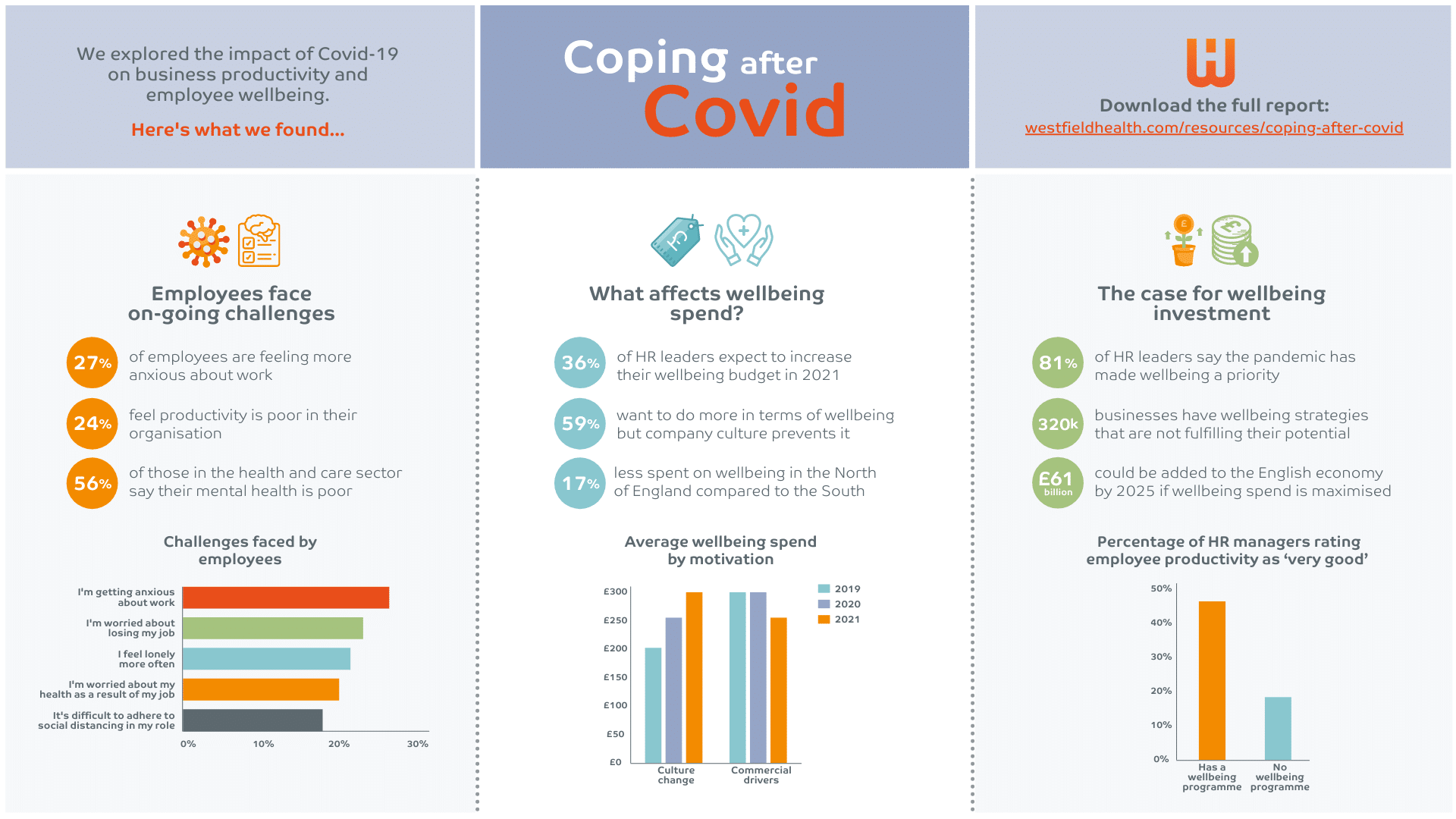Last week we unveiled our second report into the pandemic’s effect on workplace wellbeing. Based on established research, expert opinions and a survey of 1,600 employees and HR leaders, the report highlights areas for transformation and investment in wellbeing.
As employees continue to face new challenges, we explore the widening gap between those who are coping and those who are struggling. With the Government’s reopening plan still in its early stages, business leaders are faced with a valuable opportunity to develop their company culture and boost performance. So how can organisations use wellbeing to ensure their people are fit, healthy and productive in times of change?
Employees and businesses face on-going challenges
As business leaders plan their recovery, it’s important to consider how lockdown experiences have varied across different working styles, sectors and job roles. In manufacturing, over a third (39%) of employees are still worried that their workplace is not Covid secure, while in health and care over half (56%) say their mental health is poor.
Overall, 27% of employees are getting more anxious about work, suggesting that the end of lockdown will not necessarily improve mental health problems in the workplace, but rather introduce new and different challenges.
Despite this, business leaders have a real opportunity to build on 2020’s wellbeing activity and create positive organisational change. A supporting, consistent approach will help employee mental health and productivity bounce back.
Wellbeing drives performance
In 2019, LSE’s Centre for Economic Performance demonstrated a link between employee wellbeing, productivity and business performance across all industries and regions.
Similarly, a 2014 study by the Department for Business, Innovation and Skills found that wellbeing improves employee performance in three ways:
- Better wellbeing boosts cognitive ability and processes, enhancing problem solving.
- Wellbeing can improve attitudes towards work, making people more open to collaboration.
- Better mental health can impact other areas of wellbeing, increasing energy and reducing absences.
HR leaders are keen to develop their wellbeing activity, with 81% saying the pandemic has made it a priority in their organisation, but a number of roadblocks continue to stifle change. Our survey found that 59% of HR leaders would like to be able to do more in terms of wellbeing, but company culture prevents it. To win buy-in from senior leaders, wellbeing advocates must make a strong case in the boardroom for both investment and organisational change.
Investing in wellbeing pays off
The research also shows how effective wellbeing programmes can be. In organisations with a wellbeing programme in place, 43% of HR managers rated employee productivity as ‘very good’. This is compared to just 18% in organisations with no wellbeing programme.
While the pandemic drove most businesses to up their wellbeing spend in 2020, only 36% expect this increase to continue into 2021. Future wellbeing spend appears to be largely influenced by an organisation’s goals. Those citing company culture and employee morale as drivers for their wellbeing programme are the most likely to continue with budget increases. Businesses whose wellbeing activities are motivated by commercial drivers such as performance and productivity tend to predict a decrease in wellbeing spend per head.
As leaders look towards business recovery, those who underestimate the impact of a healthy workforce could find their people struggle to cope. With wellbeing established as a key driver of performance, businesses who decrease their wellbeing spend in 2021 risk missing a real opportunity. With 84% of HR leaders saying wellbeing is becoming more important, companies may find that genuine culture change is the key to success in the post-pandemic world.
This investment in wellbeing is positive not only for individual businesses but also the wider economy. While 84% of HR leaders say wellbeing support is becoming more important, an estimated 320,000 businesses have wellbeing strategies which are underperforming. If these businesses maximised their spend, the increased productivity could add £61bn to the English economy by 2025.
At a time when so many factors are outside of our control, wellbeing is one area where business leaders can focus their investment and achieve a notable return.
Coping after Covid key findings infographic

To read our in-depth analysis of wellbeing in the wider economy, including tips for how to make the case for wellbeing in your organisation, you can download the full report for free.

Download Coping after Covid: Recovering the hidden cost of the pandemic